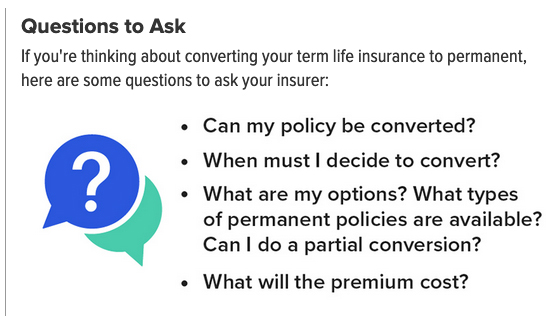Should You Convert Your Term Life to Permanent Life Insurance?
Term life insurance provides life insurance coverage for a specific time period (the term). The face amount of the policy is paid if you die during the term of the policy. When you live longer than the term of coverage, nothing is paid, as there is no cash surrender value. Permanent life insurance provides protection for your entire life, regardless of your age or health, as long as you pay the premium to keep the policy in force.
Usually, term life insurance costs less than permanent life insurance for the same amount of death benefit. Term policies often offer the opportunity to convert to permanent insurance. Here are some reasons why you might consider converting your term life insurance to permanent life insurance.
Your Health Has Changed
Since term life insurance is temporary coverage that will end after a number of years, your circumstances may have changed, warranting life insurance coverage for the rest of your life. Converting term life insurance to permanent life insurance does not require additional underwriting. This allows you to extend your life insurance coverage for the rest of your life without going through a medical exam. This fact is particularly important if your health has changed since the time you purchased the term policy.
Your Financial Circumstances Have Changed
You may have purchased term life insurance because it fit better into your budget. Now you may be able to afford the higher premium cost of a permanent life insurance policy that better fits your insurance needs.
You May Want Cash Value
Most permanent life insurance provides for the accumulation of cash value. Part of the premium goes toward the cost of the death benefit and related policy costs; another part goes toward building cash value. The interest and earnings grow tax deferred until you withdraw the funds and may be part of the income-tax-free death benefit when you die. With most cash-value life insurance, you can borrow against or take withdrawals from your cash-value account, although policy loans and withdrawals can reduce the death benefit.
You Want Funds to Pay for Final Expenses
Final expenses of a last illness and memorial and funeral costs could take quite a bite out of your assets, or worse, the assets of the loved ones you leave behind. You may want to convert some or all of your term life insurance to permanent insurance that can be used to pay for final expenses.
You Want to Leave a Legacy
The tax-free death benefit of a life insurance policy may be a cost-effective way to leave an inheritance to your loved ones. Permanent life insurance can be available no matter when you die, as long as you've kept up with the premium payments.
You May Owe Estate Taxes
 Federal estate taxes are owed on estate assets that exceed the federal estate tax exclusion ($11.7 million in 2021). In addition, several states have their own separate estate taxes and exemptions. Those you leave behind can use the death benefit of your life insurance to pay some or all of any applicable estate taxes after your death.
Federal estate taxes are owed on estate assets that exceed the federal estate tax exclusion ($11.7 million in 2021). In addition, several states have their own separate estate taxes and exemptions. Those you leave behind can use the death benefit of your life insurance to pay some or all of any applicable estate taxes after your death.
The cost and availability of life insurance depend on factors such as age, health, and the type and amount of insurance purchased. As with most financial decisions, there are expenses associated with the purchase of life insurance. Policies commonly have mortality and expense charges. In addition, if a policy is surrendered prematurely, there may be surrender charges and income tax implications. Withdrawals of the accumulated cash value, up to the amount of the premiums paid, are not subject to income tax. Loans are also free of income tax as long as they are repaid. Loans and withdrawals from a permanent life insurance policy will reduce the policy's cash value and death benefit, and could increase the chance that the policy will lapse, and might result in a tax liability if the policy terminates before the death of the insured. Additional out-of-pocket payments may be needed if actual dividends or investment returns decrease, if you withdraw policy cash values, or if current charges increase. Any guarantees are contingent on the financial strength and claims-paying ability of the issuing insurance company.
Content Prepared by Broadridge Investor Communication Solutions, Inc for financial advisor use. This information, developed by an independent third party, has been obtained from sources considered to be reliable, but Raymond James Financial Services, Inc. does not guarantee that the foregoing material is accurate or complete. This information is not a complete summary or statement of all available data necessary for making an investment decision and does not constitute a recommendation. The material is general in nature. Past performance may not be indicative of future results.
Investment products are: not deposits, not FDIC/NCUA insured, not insured by any government agency, not bank guaranteed, subject to risk and may lose value. Raymond James financial advisors do not render legal or tax advice. Please consult a qualified professional regarding legal or tax advice.
All expressions of opinion reflect the judgment of Raymond James & Associates, Inc. and are subject to change. There is no assurance any of the trends mentioned will continue or that any of the forecasts mentioned will occur. Economic and market conditions are subject to change. Investing involves risk including the possible loss of capital. The S&P 500 is an unmanaged index of 500 widely held stocks. It is not possible to invest directly in an index. The market performance noted does not include fees and charges which would affect an investor’s returns. Past performance may not be indicative of future results.


 Maggie Slivinski
Maggie Slivinski Steve Corbo
Steve Corbo Alexandra Rao
Alexandra Rao Alexa Comey
Alexa Comey Gene Donato
Gene Donato Jack W. Kennedy III, CFP®, AAMS®
Jack W. Kennedy III, CFP®, AAMS® Henry (Hank) J. Schroeder, CFP®
Henry (Hank) J. Schroeder, CFP® Diane Gallagher
Diane Gallagher Scott Bernstiel
Scott Bernstiel Chrissy Carpenter
Chrissy Carpenter David Strout
David Strout Keith R. Hering AAMS®, CRPS®, CIMA®
Keith R. Hering AAMS®, CRPS®, CIMA®  Marjorie Onuwa
Marjorie Onuwa